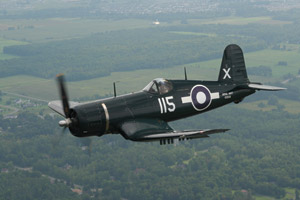
Features
Operations
Chance Vought Corsair

October 8, 2008 By Raymond Canon

Because of his heroism while flying the Corsair, Lt. Robert Gray of Nelson, B.C. earned the Victoria Cross posthumously. (Photo by Mike Henniger, Vintage Wings of Canada)
|
Among the American naval aircraft that found their way into Canada was the Chance Vought Corsair, a gull-winged high powered aircraft that saw most of its service in the Pacific theatre against the Japanese. It may have been designed to fly off of aircraft carriers but its ruggedness and versatility meant that squadrons were formed for land-based operation in that area.
The RFP (Request for Proposals) which ultimately led to the construction of the Corsair was issued even before the outbreak of the Second World War. The U.S. Navy preferred fighters with a liquid-cooled engine but both Grumman with its Wildcat and CV with the Corsair opted for air-cooled power-plants and the Navy reluctantly acquiesced. They would not be sorry!
At least the Navy did not dally. The same year an order was issued to Chance Vought for further development of their submission, and the plane first took to the air on May 1, 1940. The engine, a 1,850-hp. Pratt & Whitney Wasp, required a propeller so big that the gull wing was designed to give enough clearance when taking off and landing.
Another problem was visibility from the cockpit. This was especially true of the landings, with the British navy finally coming up with the answer. They simply had Corsair pilots use a weaving approach flaring out only at the last moment. Even at that, because of other problems on the aircraft carriers, the aircraft was assigned initially to the Marines for land-based operations in the Pacific.
In this mode it soon proved its worth. It had no trouble outflying Japanese fighters and it could also be used effectively as a fighter-bomber. It was also used extensively by the RN and it was in this regard that the following story of interest to Canadians took place:
It was while flying a Corsair off the carrier HMS Formidable that Lt. Robert Gray of Nelson, B.C. earned the Victoria Cross shortly before the end of the war. Flying the fighter-bomber version of the aircraft he attacked a Japanese destroyer off the coast of Japan and, in spite of heavy anti-aircraft fire, he pressed home his attack until he was able to score a direct hit on the warship with one of his bombs.
The latter sank almost immediately but, because of the anti-aircraft fire, Lt. Gray’s Corsair was hit a number of times, caught fire and he was unable to return to the carrier. His V.C. was thus awarded posthumously.
Almost a decade later and in spite of the arrival of the jet age, the Corsair was still able to see extensive duty as a fighter-bomber during the Korean war! Truly a superb warplane.
Raymond Canon is an aviation analyst at the University of Western Ontario.